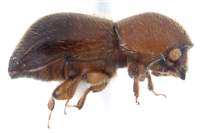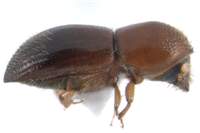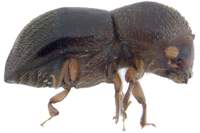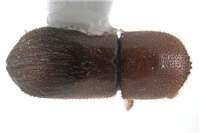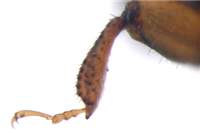Diagnosis
Main character: posterior face of protibia is inflated and tuberculate. Declivity granulate, interstriae setose, antennal club with two sutures visible on posterior face, protibia distinctly inflated and tuberculate on the posterior face protibia. Of the neotropical genera, Dryocoetoides resembles some bulky Theoborus, and differs by granulated elytral declivity.
Distribution
Neotropical, recently introduced to Africa.
Biology
Short gallery in a variety of wood sizes and species.
Taxonomy
Monophyletic (Hulcr et al. 2007).
Detailed description
Eyes shallowly emarginated, upper portion of eyes smaller than the lower part. Antennal club approximately circular, club type four not truncated, first segment anteriad smaller than second, both convex. Segment 1 of club straight (may be slightly concave or convex) on anterior face, its margin mostly costate, may appear softer on posterior side. Segment 2 of club corneous on both sides of club, but not circular (not making antenna tall, or telescopic). Segment 3 of club clearly visible on both sides of club. Segment 1 shorter than to pedicel, funicle 4-segmented. Submentum flat, flush with genae, shaped as a narrow triangle. Anterior edge of pronotum with two distinct flat denticles protruding anteriad. Pronotum from lateral view pronotal disc as long or slightly longer than anterior slope (type 7). From dorsal view basic, parallel-sided (type 2) or conical frontally, angulate (type 6). Pronotal disc shining or smoothly alutaceous, with small punctures, lateral edge of pronotum obliquely costate. Procoxae contiguous, prosternal posterocoxal process short and conical, or flat and inconspicuous. Tuft on pronotal basis associated with mesonotal mycangium absent, setae on elytral bases associated with elytral mycangium also absent. Scutellum flat, flush with elytra. Elytral bases straight, with oblique edge, elytral disc longer than declivity, and convex or bulging, punctures on elytral disc in strial lines (which may be difficult to discern). Boundary between elytral disc and declivity distinct or indistinct, disc rounded, smoothly transitioning into declivity. Lateral profile of elytral declivity rounded but steep, especially towards the apex, dorsal profile of elytral apex prolonged apically, attenuated or angulate. Elytral declivity covered with dense erect setae, often more abundant than strial punctures. Posterolateral declivital costa elevated with the carina short and inconspicuous. Surface of declivity devoid of tubercles.First interstriae parallel (sometimes slightly broadened towards elytral summit). Striae and interstria on the upper part of declivity even, flush with the surface. Protibia with evenly rounded edge or obliquely triangular, broades in 2/3 of the length. Posterior side of protibia appears inflated, often with several granules. Protibial denticles small, bases of denticles slightly elevated, protibial margin rounded, more than 8 protibial denticles present. Metatibia of normal size. Color uniformly dark brown (pronotum sometimes lighter). Length: 2.1 5.7 mm.

